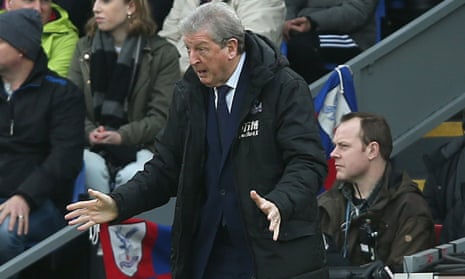The technical areas were a study in difference. On one side was the pencil thin, shaven-headed figure of Pep Guardiola, arms folded, sleek in his black bomber jacket. In the other were two figures dressed in black but that was the only similarity between them. That football could have produced two such disparate groups, practically separate species, is testament to its infinite richness.
There was Roy Hodgson, hands thrust in the pockets of his padded car coat, fretting and shrugging like an anxious owl, carefully wiping his feet every time he left the grassy area for the track. And beside him, behind him, around him, flapping about in a waterproof jacket, his assistant Ray Lewington, hair awry, arms thrusting with instruction. From behind he resembled some sort of demonic cross between Game of Thrones’ Alliser Thorne and Father Jack.
By the end, as a bruising game reached its denouement with Kevin De Bruyne and Jason Puncheon both being carried off, Guardiola took a seat next to Hodgson in the Palace dugout, like a young buck paying a new year visit to a well-loved teacher. “It was nice for Pep to come and sit down,” Hodgson said. “I know him from meeting him at Uefa seminars. It was two coaches who’ve been in the game a long time, two coaches with mutual respect for each other who took the opportunity to have a chat, which we don’t always get the chance to do.” What, after all, is Christmas time about?
Occasionally Hodgson and Lewington conferred, heads bowed in mutual grumbling, synchronised in their shrugging, or in telling Wilfried Zaha to switch flanks, the Statler and Waldorf of the dugout. And yet it worked. Implausible as it may have seemed, the Croydon Way proved equal to the Cruyffian Way. Other league opponents have sat deep against Manchester City this season and frustrated them; none has previously prevented them scoring. And none has so combined stifling City with putting them under pressure.
Palace had 10 shots and forced seven corners, more than any other side in the league against City this season. Their success came from pressuring the two areas in which City have seemed susceptible. They continue to struggle against high balls, whether crossed in from wide or hit straight over the top. Eliaquim Mangala’s hesitation under a long clearance from Wayne Hennessey in the first half was baffling and had Christian Benteke shown more composure, well, he would probably still be at Liverpool. His anxiety was a recurring theme, and the Belgian put a very good headed chance wide late on.
The other success came in wide areas, where Zaha and to a lesser extent Andros Townsend both have the pace to make opposing full-backs wary about pressing forward. The result was that, as Hodgson said, Kyle Walker and Zaha effectively “neutralised each other” for the first three quarters of the game, before Zaha and Townsend switched flanks. That was what got Zaha running at Danilo, which produced the penalty as Raheem Sterling clumsily tried to get back to him. Hodgson was reluctant to take credit, describing it as “a tactical switch my wife would have made”.
Hodgson set up his side in a 4-3-3, with Jaïro Riedewald used on the left of midfield. It was the first league game the Holland international had started under Hodgson, having been brought in by Frank de Boer from Ajax, where he operated either at the back or in midfield. Here, his job was a specific one: stopping De Bruyne. Within five minutes the Belgian was inconvenienced enough to switch with Ilkay Gündogan, and although they swapped back again for a time after Scott Dann’s injury, City’s lack of fluency was striking.
City’s irritation was clear and led to Leroy Sané being booked for petulantly kicking the ball away after a mistimed pass for him.
Certain aspects of football are eternal, even as visionaries such as Guardiola change perceptions of what is possible. Palace’s success was rooted in the values Hodgson had absorbed on Allen Wade’s first FA training course in the late 60s. That was when systematisation entered English football’s mainstream, when individuality yielded to the notion of a wider structure.
“We were excellent in terms of tactical discipline, commitment, focus and concentration,” Hodgson said.
Rightly, he preferred to focus on a point won rather than two lost due to the late penalty miss. But perhaps his greatest triumph was doing what so few managers have done this season. Palace may have had only 25.7% possession but they disrupted City to the extent that this did not look like a game of handball: this was not an attack constantly passing in front of a defence, constantly in search of an opening. Hodgson’s triumph was to make this look like a normal game.

Comments (…)
Sign in or create your Guardian account to join the discussion